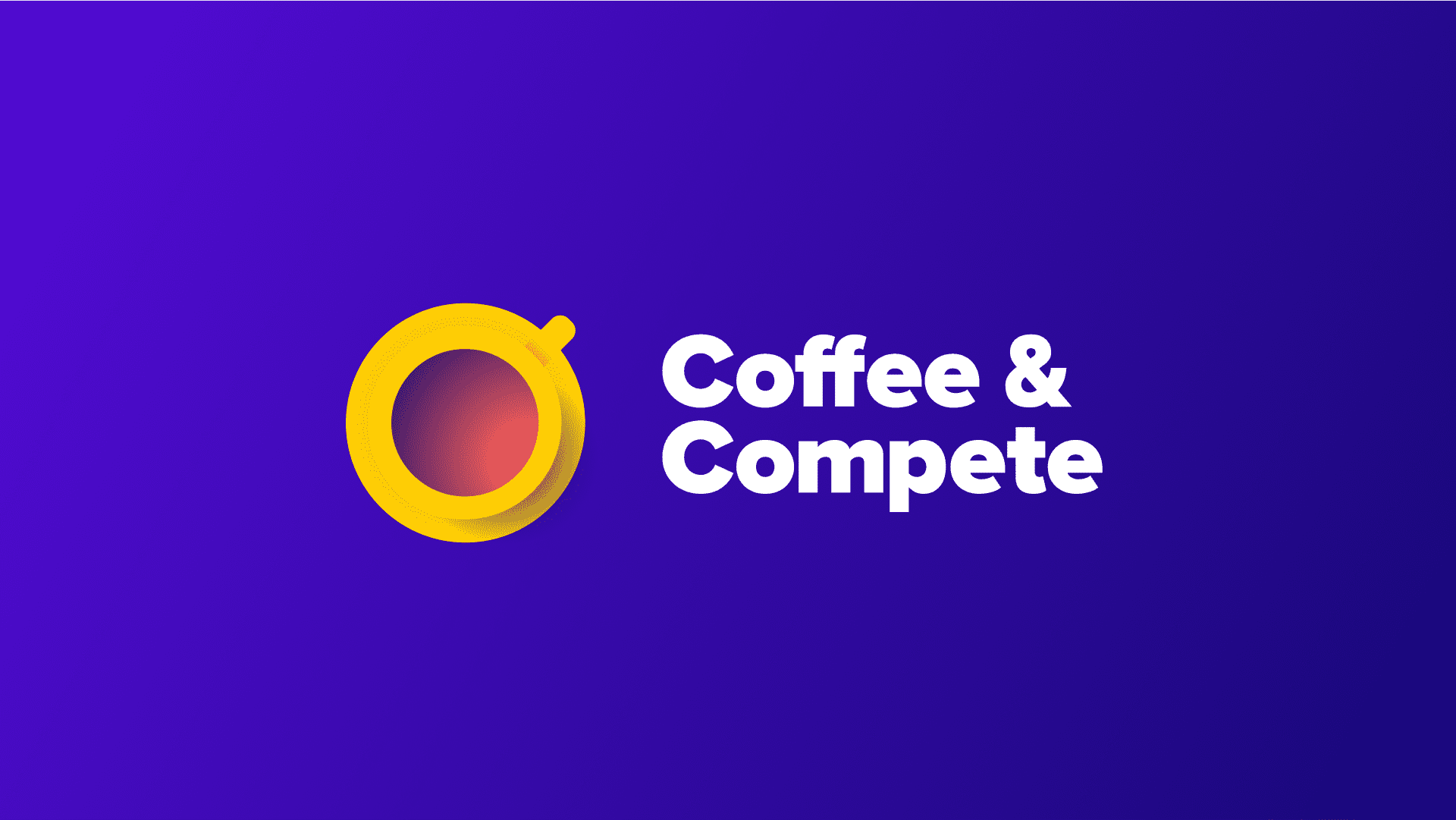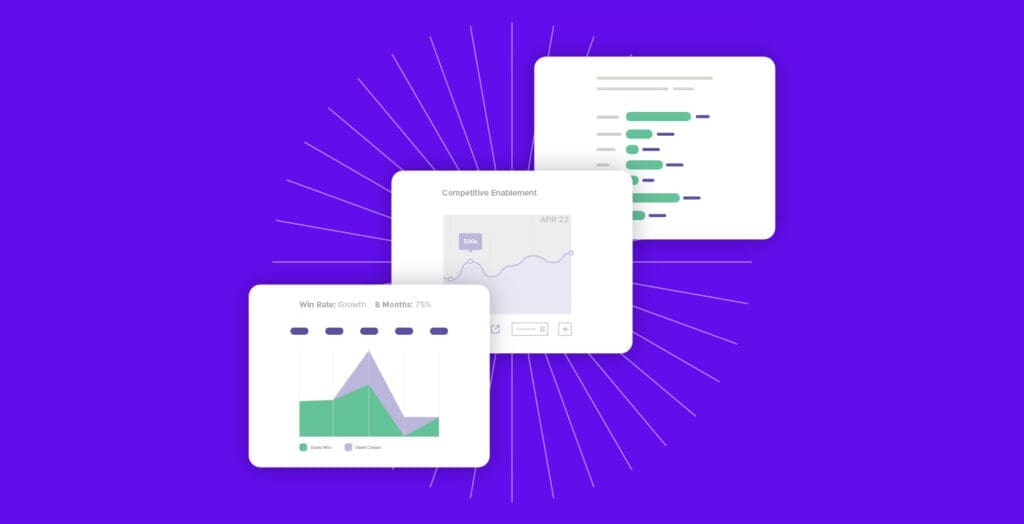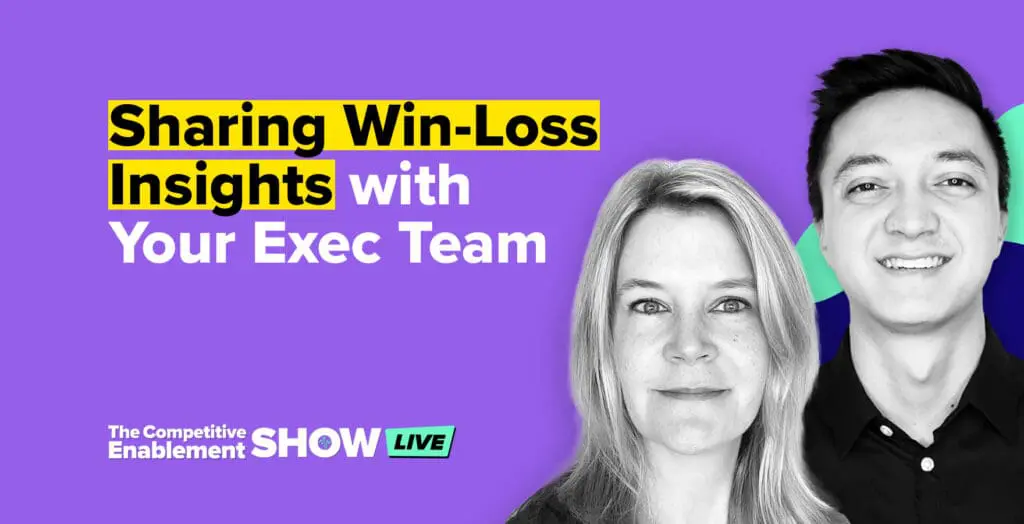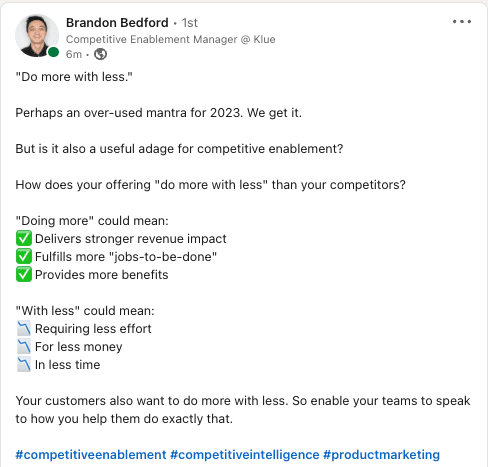Klue Compete
The Competitive Enablement Platform
Learn More
FIND OUT MORE >


As Bob Dylan said in his iconic song “Like a Rolling Stone”:
When you got nothin’ / You got nothin’ to lose
If you’re reading this email, however, you work for a business that does in fact have something to lose.
That’s why we’re obsessed with win-loss analysis — and why you should be too.
We’ve got a ton of great win-loss content coming at you in today’s ☕️ Coffee & Compete 🤜🤛
Such as:
📖 A Win-Loss Analysis Executive Summary Presentation Template
🎙 How to share win-loss insights with your executive team
🎤 What doing less with more really means
👷 And CE and CI jobs you’re going to want to apply for
Let’s roll,
Ben 🪨

You probably have a treasure trove of win-loss data already at your disposal tucked away in your CRM. You may have even started conducting win-loss interviews, collecting data and drawing insights.
But if you can’t effectively communicate and share those insights with your execs, you’ve wasted your time.
So we put together a little resource to help you out: a Win-Loss Analysis Template for Your Executive Summary.
Here are the Coles Notes on what you need to know.
Unearthing insights from win-loss interviews requires sorting the data into common themes and then highlighting 2-3 of the most important trends you see.
“Important” usually boils down to frequency. If the same theme comes up multiple times across different interviews, it’s a good indicator that it’s a trend worth surfacing.
But it’s not just a question of quantity. Trends that maybe came up less frequently, but are particularly interesting, counterintuitive, or completely unexpected can also be valuable to share with execs.
The key here is to land on two or three trends and present those to your executives — no more than that.
As Forrester’s VP of Customer Experience Derek O’Grady says, “Don’t throw a thousand things at your execs. Give them the top three headlines of what you learned.”
Keeping it to 2-3 highlights will give you the best chance of hitting the three C’s of presenting to execs:
The biggest perceived limitation of win-loss interview data is the relatively small sample size.
One way to overcome this limitation is to use quantitative data from a larger data set in conjunction with your qualitative interview data.
CRM data for example is a great place to go for understanding what competitors are coming up most frequently in deals, and what percentage of those you’re winning or losing.
If you need a convincingly large dataset to justify some of the decisions or recommendations you’re making, your CRM might be the best place to go.
Ultimately the best way to deliver your win-loss insights is to understand your audience and tailor your presentation to their needs.
So while qualitative data generally surfaces the most impactful insights, some members of your exec team will need to see more quantitative data to be convinced.
And it’s your job to make sure they get what they need.
🧑🏫 Present quarterly to execs and monthly to everyone else 🧑🏫
You should strive to get in front of your executive team once a quarter to share your win-loss insights. This is Jennifer Roberts’s ideal cadence and a reasonable goal to set for yourself.
But it doesn’t mean that win-loss insights need to sit on the shelf in the interim. Part of the value of win-loss analysis is in ongoing research.
So while you may only have enough insights to build an executive presentation once per quarter, some teams and departments will still benefit from monthly readouts.
On a recent episode of the Competitive Enablement Show with Community Brands’ Tirrah Switzer, Tirrah says that she’s in the habit of doing monthly or bi-monthly readouts to different teams across the org.
“We do a readout for the general manager of that product line, the product team, head of demand gen, customer success, and sales.”
The readouts aren’t as formalized or high-stakes as the quarterly exec presentations. But the monthly cadence allows your win-loss program to increase to stay top of mind.
Without a doubt, the insights you get from win-loss analysis can and should inform strategic decision-making across the organization.
But in order to get there, you’ll need to present those insights to your executive team.
And we’ve got a downloadable, customizable template to help you do just that. 👇




The best part of Competitive Enablement LIVE is the community involvement. This week’s session was no different.
In fact it was someone from the audience — our friend and competitive intelligence wizard Dustin Ray — who dropped the best metaphor we’ve heard yet for explaining how quantitative and qualitative work together for win-loss analysis.
Quantitative win-loss data (from your CRM) is like a radar system that lets you scan a wide area and see hot spots from a bird’s eye view.
Another way to think of it is that CRM data helps answer “what” or “which” questions:
But it’s the “why” questions that uncover the most powerful insights — and the ones best answered by win-loss interview data.
Because win-loss analysis isn’t just about learning what’s going wrong or right, it’s about deeply understanding why it’s happening in the first place.
Watch, listen and check out three takeaways from this week’s CE LIVE on our episode recap page.
A concise and powerful plug for why your organization needs a competitive enablement program in 2023 — from the competitive enablement guy at the competitive enablement company.
Because efficiency isn’t just about more revenue and less cost.
It’s saving time and reducing the effort required in order to generate more business and cover more bases with fewer employees.
Following Brandon on LinkedIn is one way to stay up to date on all things competitive enablement.
And for a quick reminder of why it’s so important, check out our website.


Thanks for reading this week’s edition of Coffee & Compete. As always, please reach out to me and the rest of the team with your thoughts and feedback. And If you know someone who isn’t already subscribed to Coffee & Compete, be a good friend and tell them about us. |


Product marketers conducting competitive research are drowning in reviews, reports, and messy notes. Here's how Klue's AI foundation will help you complete this analysis in seconds, not weeks.
The topic of Large Language Models (LLMs) has a lot of confusion. Here's what you need to know about how Klue is working with them.
Let’s do it. Tell us a bit about yourself and we’ll set up a time to wow you.
Let's do it. Tell us a bit about yourself and we'll set up a time to wow you.
XLet's do it. Tell us a bit about yourself and we'll set up a time to wow you.
XSubscribe to get our latest AI functionality and news in your inbox.
XOur Buyer Pulse feature, set to launch in Q2 2024, offers valuable insights into the factors influencing buyer decisions in your pipeline. By signing up for the waitlist, we can better gauge interest and proactively engage with you to streamline the setup and integration process before the feature becomes widely available.
X